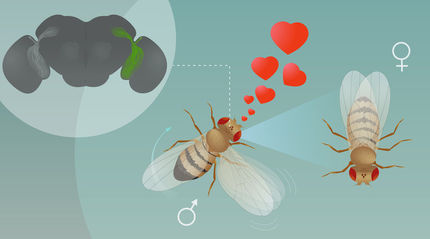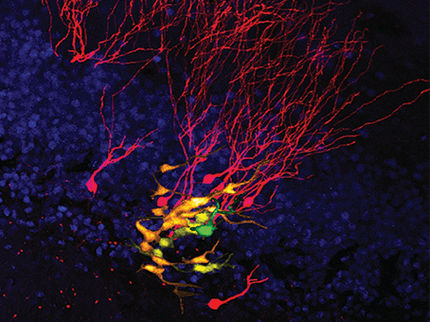Riddle of proteins in the brain solved
Erin Schuman awarded the Körber European Science Prize, worth one million euros
The American neurobiologist Erin Schuman is a pioneer in neurobiology. Schuman’s work has revolutionised our understanding of how individual brain cells – so called neurons – work. She discovered that and how proteins, as critical building blocks of the cells, are locally produced at the interfaces between neurons. Schuman’s newly discovered mechanism supplies the protein needed for communication between neurons, for storing memories, and for overall brain development. Building on these findings, she plans to use the Körber Prize funds to investigate disease-related changes in neuronal proteins, paving the way for new therapy options.
Proteins are the main players in all cells, including neurons. They are what allow billions of neurons to communicate with one another, allow memories to be stored, and allow the brain’s structure to form and remain flexible.
Before Schuman’s breakthrough, it remained a mystery how the millions of required proteins were produced and distributed to the proper locations in neurons. Neurons are very large cells and feature complicated processes that allow them to interconnect with thousands of other neurons at specialised junctions called synapses. Schuman determined that neurons produce proteins directly at the synapses – and not just in the cell body, as was long assumed. The discovery of this mechanism is fundamental to grasping key processes in the brain, like learning and memory formation.
Disruptions in brain protein levels are a main cause of brain disorders like Huntington’s disease and Fragile X syndrome. “The research on this aspect is still in its infancy, but we already know that imbalances in the composition of neuronal proteins can lead to serious disorders,” says Schuman. In her current research projects, her goal is to identify how proteins change during brain disorders, potentially opening new avenues for treatment.
A new perspective on the brain
For many years, the standard assumption in the field of brain research was that proteins were produced in the cell bodies of neurons; that is precisely how protein synthesis works in other types of cells. But in the brain, this mechanism of protein synthesis would be problematic: “If proteins were only produced in the cell body and then transported to the synapses, the neuron would have a major housekeeping issue,” explains Edvard Moser, Nobel Prize winner for Physiology and Medicine and Chair of the Search Committee for the Körber Prize. For example, when the synapses of a given neuron are changed as a result of learning, the proteins would have to find their way to exactly these synapses while avoiding the thousands of other synapses of the cell. “With many thousands of synapses per neuron and hundreds of thousands of proteins generated per minute, the required sorting and transporting would be at an astronomic scale,” says Moser. As such, neuronal protein synthesis, and therefore the basis of brain processes like learning and remembering, remained a mystery.
Schuman’s work was essential to solving this riddle. In a trailblazing study, she demonstrated that synapses continue to produce proteins even when physically separated from their cell bodies. This finding caused quite a stir, as it implied that the required proteins could not be produced in the cell body but were instead locally produced at the synapses – a clear contradiction to textbook explanations. “When I first shared the data, the idea was called ‘crazy’ by more than one of my colleagues,” Schuman recalls.
Schuman’s discovery was a revolution in brain research. And she did not stop there – while her previous findings had focused on a limited number of essential proteins, she and her team subsequently confirmed that in fact thousands of different proteins are produced locally at the synapses.
Basis for new treatment options
In the future, Schuman’s breakthrough in basic research could be of critical medical value. “There is increasing evidence that many neurodevelopmental and neurodegenerative diseases are diseases of the synapse,” says Schuman. Examples include Fragile X syndrome, Huntington’s disease, and Rett syndrome. These diseases are associated with a reduction or total loss of cognitive performance, learning disabilities and delayed linguistic development. Using the funding from the Körber Prize, Schuman plans to investigate the synaptic changes produced by these diseases. “Ideally, this work will not only advance the state of research but also provide the basis for new treatments at the molecular level. If we’re successful, the future may hold better treatment options for those affected by brain disorders.”
The researcher
Born in 1963, Erin Schuman has been Director at the Max Planck Institute for Brain Research in Frankfurt, Germany, since 2009. She is also a co-opted Professor at Frankfurt’s Goethe University since 2015 and a Guest Professor at Radboud University in the Netherlands since 2021. Born and raised in San Gabriel, California, she studied psychology at the University of Southern California before completing her Ph.D. in neuroscience at Princeton University. This was followed by postdoctoral training at Stanford University and her first faculty position at the California Institute of Technology, where she was appointed Assistant Professor in 1993 and Full Professor in 2004. In 1997, she was appointed as an Investigator of the Howard Hughes Medical Institute. She is a member of the German National Academy of Science, Leopoldina, the U.S. National Academy of Science as well as a Foreign Member of the U.K.’s Royal Society. In 2023, she was awarded the coveted Brain Prize, bestowed by Denmark’s Lundbeck Foundation.
In addition to her research, the sixty-one-year-old Schuman works to increase the percentage of women in science, and to promote educational opportunities in science for young people. In addition, she has worked intensively with her colleagues to clarify the history of her institute under National Socialism.
The Körber Prize
The Körber European Science Prize will be presented to Erin Schuman on 20 September 2024 in the Grand Hall of the Hamburg City Hall. Endowed with one million euros, the Körber Prize is one of the world’s most valuable science prizes. The money is to be used for research and science communication, with ten percent being available for the prize winner’s personal purposes. Since 1985, the Körber-Stiftung has awarded the Körber Prize in recognition of major breakthroughs in the physical or life sciences in Europe. To date, eight recipients of the Körber Prize have also been awarded the Nobel Prize.
The award ceremony will be part of the first Hamburg Science Summit. On 19 and 20 September, the Summit, which is hosted by the Körber-Stiftung and Hamburg’s Ministry of Science, will bring together experts and decision-makers from science, politics, business and think-tanks. This year’s focus will be on Europe’s technological sovereignty.































































